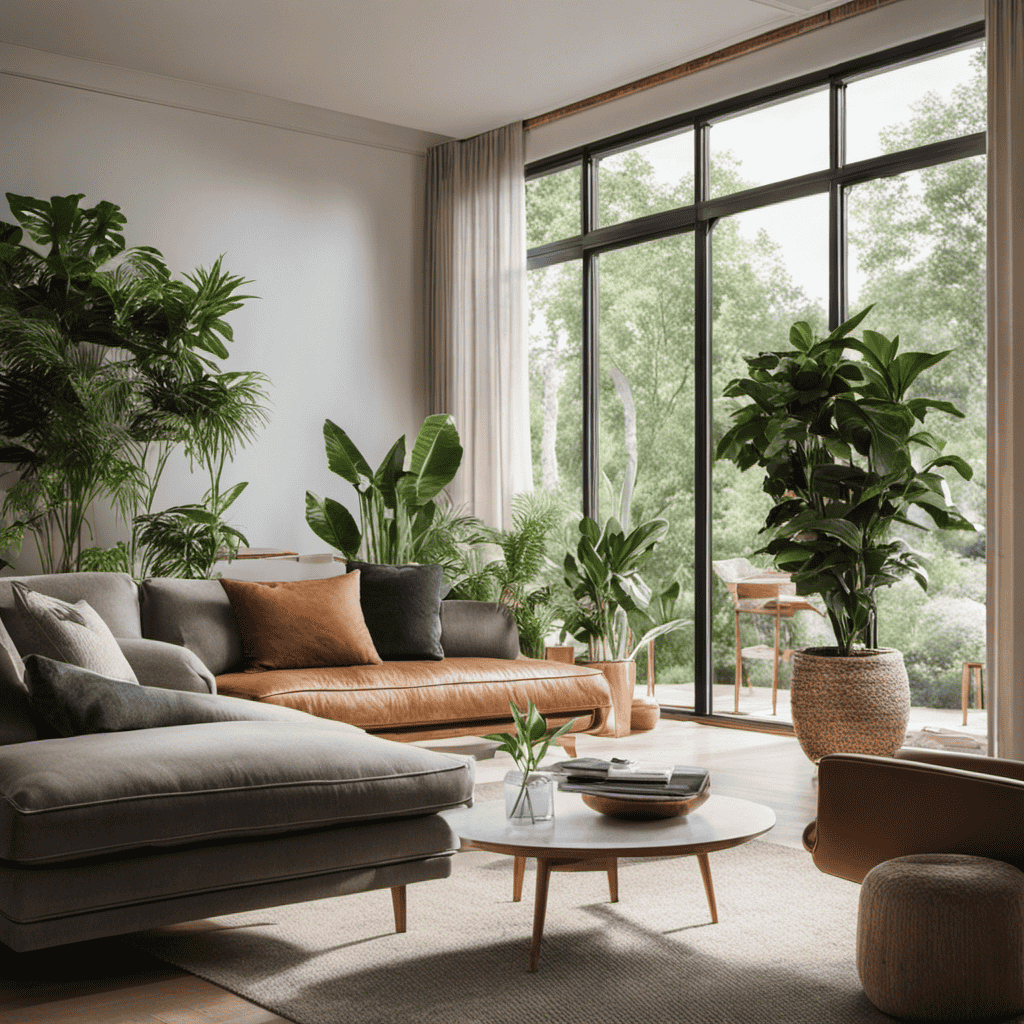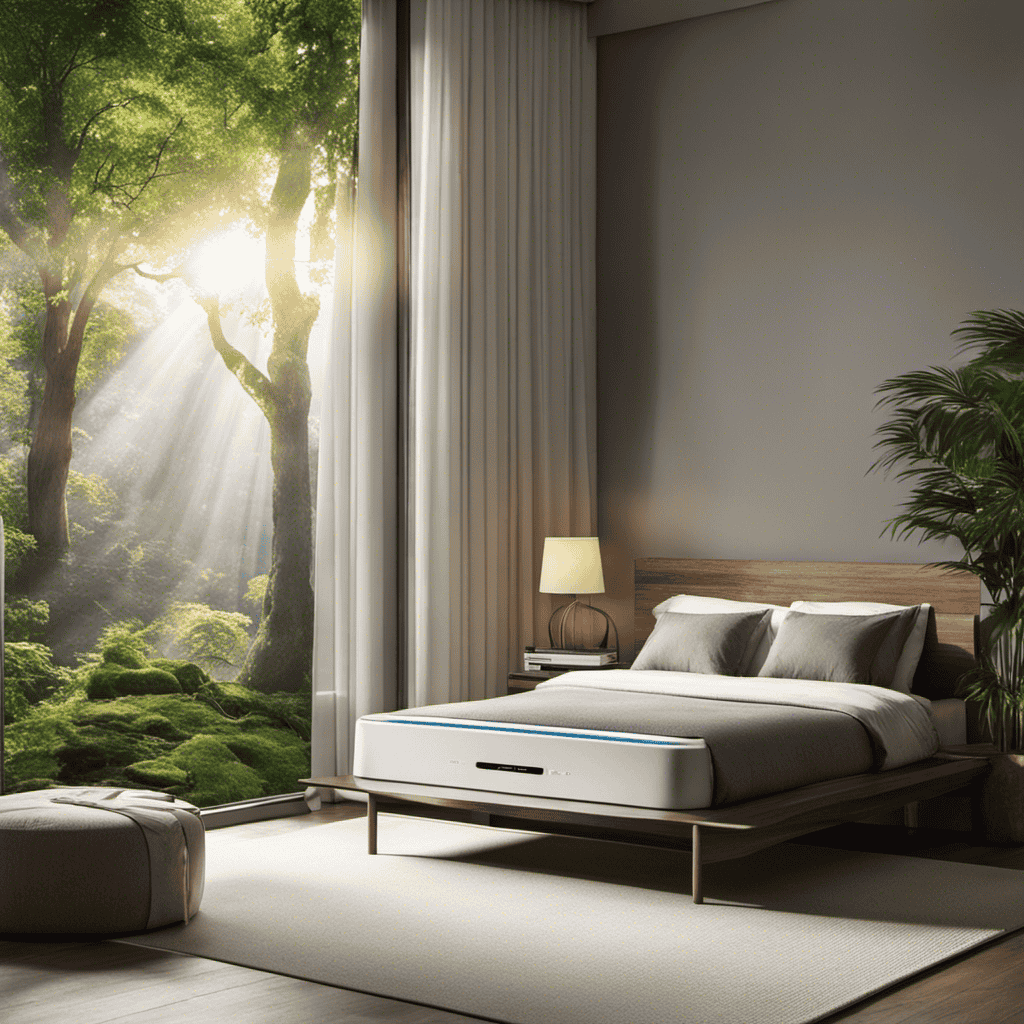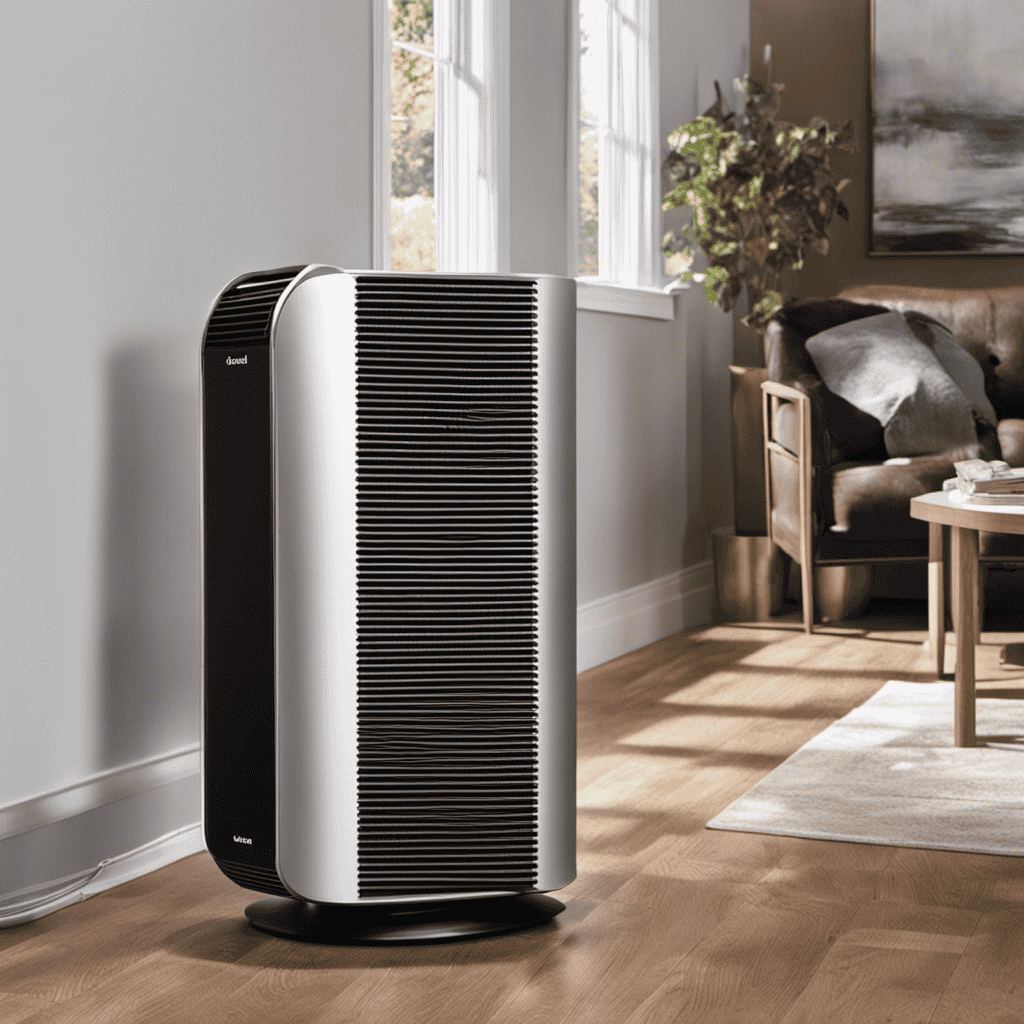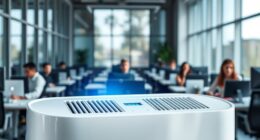As the owner of an air purifier, I frequently ponder the best location to place my device for optimal efficiency.
In this article, I will provide you with a comprehensive guide on where to put your air purifier in various rooms of your home.
From the bedroom to the kitchen, the nursery to the pet area, I will explore the best placement options to ensure optimal air quality and allergy relief.
So, let’s dive in and find the perfect spot for your air purifier.
Key Takeaways
- Consider the size of your bedroom when choosing an air purifier
- Place the air purifier in the living room for optimal filtration
- Avoid placing the air purifier near direct heat sources in the kitchen
- Choose a spot for the air purifier in the home office that allows for effective circulation of clean air
Bedroom Placement
You should place your air purifier in your bedroom to ensure clean and fresh air while you sleep. When considering the placement of your air purifier, it is important to take into account the size of your bedroom and the noise level of the purifier.
Firstly, the size of your bedroom is an important factor to consider when placing your air purifier. Air purifiers come in different sizes, and you should choose one that is suitable for the size of your bedroom. A larger bedroom may require a more powerful purifier, while a smaller bedroom may only need a compact purifier. It is recommended to check the manufacturer’s guidelines for the recommended room size for optimal performance.
Secondly, the noise level of the air purifier is another crucial aspect to consider. Some air purifiers can be quite noisy, which can disrupt your sleep and be distracting. Therefore, it is recommended to choose an air purifier that operates quietly, especially for the bedroom. Look for purifiers that have a low noise level, usually measured in decibels (dB), to ensure a peaceful sleeping environment.
Living Room Placement
When considering the optimal placement for your living room, it’s important to take into account factors such as air circulation and overall comfort.
Proper air circulation ensures that the room remains well-ventilated, reducing the potential for stuffiness or odors.
Additionally, strategic placement of furniture and electronics can optimize the flow of air within the space, creating a more pleasant and enjoyable living environment.
Optimal Living Room Placement
To maximize effectiveness, place your air purifier in the living room where it will filter the air most efficiently.
When choosing the optimal location for your air purifier, consider the size of the room and the noise level generated by the unit.
Larger air purifiers are better suited for bigger spaces, as they have a higher air exchange rate and can handle more air volume. Smaller units may be overwhelmed by the size of the room and may not effectively clean the air.
Additionally, consider the noise level of the air purifier. Some models can be quite loud, which may be disruptive in a living room setting. Look for air purifiers with low noise levels, so that you can enjoy clean air without the distraction of constant noise.
Air Circulation Considerations
For optimal air circulation, it is important to ensure that the living room is well-ventilated. This will allow the air purifier to effectively filter and clean the air. Here are some key considerations to keep in mind when it comes to air circulation and your air purifier:
-
Placement: Position the air purifier in a central location in the room. This will help maximize airflow and ensure that the air is properly circulated. It is also important to keep the purifier away from walls and furniture to prevent any obstructions.
-
Size: When choosing an air purifier for your living room, make sure to select one that is appropriately sized. Consider the square footage of the room and the recommended coverage area of the purifier. This will ensure that the purifier can effectively clean the air in your living room.
-
Noise Level: Pay attention to the noise level of the air purifier. It is important to look for models that have a low noise output, especially if you plan to use it in the living room where quiet relaxation is important. This will ensure that the purifier does not disrupt the peaceful atmosphere of your living room.
-
Regular Maintenance: To ensure optimal performance and air quality, it is important to clean or replace the filters of your air purifier regularly. This will help keep the purifier running efficiently and effectively.
Considering these factors will help you make the most of your air purifier in the living room and enjoy cleaner, fresher air. Now, let’s move on to discussing the placement of air purifiers in the kitchen.
Kitchen Placement
In the kitchen, you’ll want to find a spot for your air purifier that is away from direct heat sources like the stove or oven. This is because heat can potentially damage the internal components of the purifier and reduce its effectiveness. Additionally, placing the purifier near a heat source can also cause the air around it to become warmer, which may hinder its ability to efficiently filter and purify the air in the kitchen.
When considering where to place your air purifier in the kitchen, it’s important to take into account the kitchen ventilation system. If you have a range hood or exhaust fan, it’s best to position the air purifier near these areas. This will allow the purifier to capture and filter any cooking odors or smoke that may be generated during your culinary endeavors. By placing the purifier near the kitchen ventilation system, you can maximize its ability to remove these odors and improve the overall air quality in your kitchen.
Home Office Placement
When considering the ideal location for an air purifier in my home office, there are several factors to take into account.
First, it’s important to choose a spot where the purifier can effectively circulate clean air throughout the space. This may involve positioning it in a central area, away from any obstructions or furniture that could impede airflow.
Additionally, considering the proximity to potential sources of pollutants, such as printers or electronics, is crucial in order to maximize the purifier’s efficiency.
Ideal Air Purifier Location
The best place to put your air purifier is near a window or door. This strategic placement allows for efficient airflow and effective filtration of outdoor pollutants. Here are some reasons why this location is ideal:
-
Noise reduction: Placing the air purifier near a window or door helps mask the noise it produces. This way, you can enjoy clean air without the distraction of excessive noise.
-
Fresh air intake: By positioning the air purifier near a window or door, it can easily draw in fresh outdoor air for purification. This ensures a constant supply of clean and healthy air.
-
Maintenance convenience: Placing the unit near a window or door makes it easier to access for regular maintenance tasks such as filter replacement or cleaning. This ensures that your air purifier functions optimally and prolongs its lifespan.
-
Optimized airflow: The proximity to a window or door allows for improved circulation of clean air throughout the room, increasing the overall effectiveness of the air purifier.
Considering these factors, it is clear that the strategic placement of your air purifier near a window or door is crucial for optimal performance and maintenance convenience.
Factors to Consider
Now that we know where the ideal location for an air purifier is, let’s discuss some factors to consider when choosing the right spot.
One important factor is the size of the air purifier. Larger air purifiers require more space, so it’s essential to ensure that you have enough room for it to operate effectively.
Additionally, noise level considerations are crucial, especially if you plan to place the air purifier in a bedroom or living area. Some air purifiers can produce a noticeable amount of noise, which may disrupt sleep or cause annoyance during daily activities. Therefore, it’s important to choose an air purifier with a noise level that suits your preferences.
By considering the air purifier size and noise level, you can find the perfect spot in your home for optimal air purification.
Now, let’s move on to the next section and discuss the placement of air purifiers in nurseries.
Nursery Placement
In the nursery, it’s important to find the best placement for your air purifier to ensure clean air for your baby. When considering where to put your air purifier, keep in mind both nursery decor and baby safety. Here are some key points to consider:
-
Distance from the crib: Place the air purifier at least 3 feet away from the crib to prevent any potential hazards. This ensures that the baby won’t accidentally knock it over or pull on any cords.
-
Elevated position: Position the air purifier at an elevated level, such as on a shelf or a dresser, to maximize its air cleaning efficiency. This also helps to keep it out of reach of curious little hands.
-
Central location: Choose a central location in the nursery for the air purifier to allow for better air circulation. This ensures that the purified air can reach all corners of the room, providing a healthier environment for your baby.
-
Avoid obstructions: Keep the air purifier away from any obstructions, such as curtains or furniture, that could block the airflow. This allows the purifier to effectively capture and remove airborne pollutants.
Basement Placement
When considering where to position your air purifier in the basement, it’s crucial to choose a spot that allows for optimal air circulation. Proper basement ventilation is key to maintaining a clean and healthy environment.
Basements are prone to high humidity levels, musty odors, and the accumulation of dust and allergens. By strategically placing your air purifier, you can effectively control these issues and improve the air quality in your basement.
To start, identify areas in your basement where air circulation is limited. These could be corners, storage spaces, or areas near damp walls. These spots are likely to have poor ventilation and are ideal for placing your air purifier. Additionally, consider placing it near sources of potential basement odors, such as the laundry area or bathroom.
When positioning your air purifier, ensure that it is not obstructed by furniture or other objects. This will allow for unobstructed airflow and maximize its effectiveness. It is also important to regularly clean and maintain your air purifier to ensure optimal performance.
Bathroom Placement
To optimize air circulation in your bathroom, it’s crucial to choose a spot that allows for unobstructed airflow and maximizes the effectiveness of your air purifier. Here are some tips to help you with bathroom placement of your air purifier:
-
Consider the size of the air purifier: Make sure the air purifier you choose is compact enough to fit comfortably in your bathroom without taking up too much space. A smaller unit will be easier to position and won’t obstruct your daily activities.
-
Find a strategic location: Place the air purifier near the source of pollutants, such as the toilet or shower, to capture them before they spread throughout the room. Avoid placing it too close to the sink or bathtub, as moisture can damage the unit.
-
Maintain proper ventilation: Ensure that the air purifier is not blocking any vents or windows, as this can hinder air circulation. Proper ventilation will help the purifier work more efficiently and effectively.
-
Regular maintenance: Regularly clean and replace the filters in your air purifier to keep it running optimally. Follow the manufacturer’s instructions for maintenance to ensure its longevity and effectiveness.
Pet Area Placement
When it comes to placing my air purifier in relation to my pet’s litter box, I want to ensure that I am considering both convenience and air quality.
It is important to position the air purifier near the litter box to effectively capture any odors or particles that may be released.
However, it is equally important to keep the air purifier away from allergies-prone areas such as bedrooms or living rooms to prevent the spread of allergens throughout the house.
Near Litter Box
Placing my air purifier near the litter box will help minimize odors. By positioning the air purifier strategically, I can effectively remove unpleasant smells and create a better environment for both me and my furry friend. Here’s how placing the air purifier near the litter box can benefit me:
-
Odor Elimination: The air purifier will capture and filter out the litter box odors, keeping the air fresh and clean.
-
Improved Air Quality: The purifier’s filtration system will remove airborne particles, such as dust and dander, improving the overall air quality in the area.
-
Noise Reduction: Many air purifiers operate silently, ensuring a peaceful environment for both me and my pet.
-
Convenience: Placing the air purifier near the litter box means I don’t have to worry about moving it around or finding another location. It’s a hassle-free solution.
Overall, positioning the air purifier near the litter box is a smart choice for minimizing odors, improving air quality, reducing noise, and adding convenience to my pet care routine.
Away From Allergies?
Keeping the air purifier away from allergens can help alleviate symptoms for those with sensitivities. When it comes to bedroom allergies, it is important to place the air purifier in a strategic location.
Ideally, it should be positioned near the bed to ensure maximum air purification during sleep. Placing it on a nightstand or dresser is a great option. However, be sure to keep it at least a few feet away from walls or furniture to allow proper air circulation.
In the living room, where allergies can also be a concern, consider placing the air purifier in an area where it can effectively cover the entire space. This could be near a central location or in a corner, depending on the layout of the room.
Remember to regularly clean and maintain the air purifier to ensure its effectiveness in reducing allergens.
Allergy Relief Placement
To improve allergy relief, you should consider placing your air purifier in the room where you spend the most time. Here are four reasons why this placement is crucial for maximum effectiveness:
-
Air Purifier Size: When choosing an air purifier, it is important to consider the size of the room where you plan to place it. A larger room will require a more powerful purifier to effectively clean the air. By placing the air purifier in the room where you spend the most time, you ensure that you are getting the most benefit from its size and capacity.
-
Targeted Allergen Removal: Placing the air purifier in the room where you spend the most time allows it to specifically target and remove allergens that you are exposed to on a regular basis. By focusing its efforts on the space where you spend the majority of your time, the air purifier can effectively reduce your exposure to allergens and provide relief from allergy symptoms.
-
Continuous Protection: By placing the air purifier in the room where you spend the most time, you ensure that you are continuously protected from allergens. Whether you are sleeping, working, or relaxing, the air purifier will be actively filtering the air, providing you with clean and allergen-free air throughout the day and night.
-
Portable Options: Many air purifiers are portable and can easily be moved from one room to another. This flexibility allows you to place the air purifier in the room where you spend the most time, whether it is your bedroom, living room, or home office. You can easily move the purifier as needed to ensure that you are getting the maximum allergy relief in the spaces where you need it most.
Multi-level Placement
If you live in a multi-level home, it’s important to consider the best location for your air purifier on each floor. Proper placement ensures the multi-level effectiveness of your air purifier and maximizes its ability to clean the air in your home.
When deciding where to place your air purifier, there are a few key factors to consider.
Firstly, consider the layout of your home. Ideally, you should place an air purifier in a central location on each floor. This allows for even distribution of clean air throughout the entire floor. Additionally, placing the air purifier near areas with high pollutant levels, such as kitchens or pet areas, can further improve its effectiveness.
Energy consumption should also be taken into consideration. It’s important to place the air purifier in a location that allows for efficient air circulation. Avoid placing it in corners or behind furniture, as this can obstruct airflow and increase energy consumption. Instead, choose an open area with ample space around the unit.
Frequently Asked Questions
Can I Place My Air Purifier on a Shelf or Should It Be on the Floor in the Bedroom?
I can place my air purifier on a shelf or on the floor in the bedroom. The decision depends on personal preference and the layout of the room.
Placing it on a shelf can be convenient and save floor space. However, placing it on the floor ensures better air circulation and coverage.
Consider factors such as room size, furniture placement, and accessibility when deciding where to position your air purifier.
Will an Air Purifier Be Effective in a Large Living Room or Should I Consider Multiple Units?
An air purifier can be effective in a large living room, but it may require multiple units to achieve optimal results.
The size and layout of the room can impact the purifier’s effectiveness in removing pollutants.
Placing multiple units strategically throughout the room can ensure better air circulation and coverage.
Consider factors such as the purifier’s CADR (Clean Air Delivery Rate) and the room’s square footage when determining the number of units needed for maximum efficiency.
Is It Safe to Place an Air Purifier on the Kitchen Countertop Near the Stove?
Placing an air purifier on the kitchen countertop near the stove may not be the safest option. Heat from the stove can affect the effectiveness of the purifier and potentially damage its internal components.
It is important to consider alternatives to kitchen countertop placement for air purifiers, such as placing them on nearby shelves or tables. This ensures optimal air purification without compromising the device’s performance.
Can I Use an Air Purifier in My Home Office if I Have a Lot of Electronics?
I can definitely use an air purifier in my home office, even if I have a lot of electronics. It’s important for air purifier maintenance and to reap the benefits of using one in a home office.
Air purifiers help remove airborne pollutants and allergens, creating a cleaner and healthier environment. They can effectively filter out dust, pet dander, and even volatile organic compounds (VOCs) released from electronics.
Proper placement and regular filter changes are key to maximizing the air purifier’s performance.
Should I Place an Air Purifier in the Nursery Even if My Baby Doesn’t Have Allergies?
I should definitely place an air purifier in the nursery, even if my baby doesn’t have allergies. Air purifiers have numerous benefits, including removing airborne particles, allergens, and pollutants from the air.
This can help create a healthier environment for my baby, promoting better respiratory health and reducing the risk of respiratory illnesses.
Additionally, regular air purifier maintenance, such as cleaning or replacing filters, ensures optimal performance and efficiency in purifying the air.
Conclusion
In conclusion, proper placement of an air purifier is essential for optimum performance and effectiveness. By strategically placing your air purifier in key areas such as the bedroom, living room, kitchen, home office, nursery, bathroom, pet area, and allergy relief zones, you can improve the air quality and create a healthier environment.
Did you know that according to a study conducted by the Environmental Protection Agency, indoor air pollution can be two to five times higher than outdoor pollution? This statistic highlights the importance of using air purifiers to combat indoor air pollutants.










